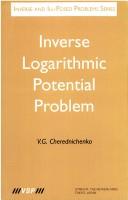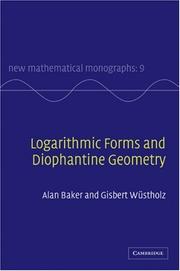| Listing 1 - 5 of 5 |
Sort by
|

ISBN: 3110900122 9783110900125 9789067642026 9783110355369 Year: 1996 Publisher: Utrecht, the Netherlands
Abstract | Keywords | Export | Availability | Bookmark
 Loading...
Loading...Choose an application
- Reference Manager
- EndNote
- RefWorks (Direct export to RefWorks)
Logarithms. --- Inverse problems (Differential equations) --- Mathematics. --- Math --- Science --- Differential equations --- Logs (Logarithms) --- Algebra
Book
ISBN: 1400852188 9781400852185 9781322075747 1322075743 9780691155708 0691155704 Year: 2014 Publisher: Princeton
Abstract | Keywords | Export | Availability | Bookmark
 Loading...
Loading...Choose an application
- Reference Manager
- EndNote
- RefWorks (Direct export to RefWorks)
John Napier (1550-1617) is celebrated today as the man who invented logarithms-an enormous intellectual achievement that would soon lead to the development of their mechanical equivalent in the slide rule: the two would serve humanity as the principal means of calculation until the mid-1970s. Yet, despite Napier's pioneering efforts, his life and work have not attracted detailed modern scrutiny. John Napier is the first contemporary biography to take an in-depth look at the multiple facets of Napier's story: his privileged position as the eighth Laird of Merchiston and the son of influential Scottish landowners; his reputation as a magician who dabbled in alchemy; his interest in agriculture; his involvement with a notorious outlaw; his staunch anti-Catholic beliefs; his interactions with such peers as Henry Briggs, Johannes Kepler, and Tycho Brahe; and, most notably, his estimable mathematical legacy.Julian Havil explores Napier's original development of logarithms, the motivations for his approach, and the reasons behind certain adjustments to them. Napier's inventive mathematical ideas also include formulas for solving spherical triangles, "Napier's Bones" (a more basic but extremely popular alternative device for calculation), and the use of decimal notation for fractions and binary arithmetic. Havil also considers Napier's study of the Book of Revelation, which led to his prediction of the Apocalypse in his first book, A Plaine Discovery of the Whole Revelation of St. John-the work for which Napier believed he would be most remembered.John Napier assesses one man's life and the lasting influence of his advancements on the mathematical sciences and beyond.
Mathematicians --- Logarithms. --- Scientists --- Logs (Logarithms) --- Algebra --- Napier, John, --- Scotland. --- Caledonia --- Ecosse --- Schotland --- Scotia --- Škotska --- Sŭkʻotʻŭlland --- Great Britain

ISBN: 9780511542862 9780521882682 9780511378645 0511378645 9780511375903 0511375905 0521882680 1107185424 1281243183 9786611243180 0511377754 0511376847 0511374402 0511542860 Year: 2007 Publisher: Cambridge : Cambridge University Press,
Abstract | Keywords | Export | Availability | Bookmark
 Loading...
Loading...Choose an application
- Reference Manager
- EndNote
- RefWorks (Direct export to RefWorks)
There is now much interplay between studies on logarithmic forms and deep aspects of arithmetic algebraic geometry. New light has been shed, for instance, on the famous conjectures of Tate and Shafarevich relating to abelian varieties and the associated celebrated discoveries of Faltings establishing the Mordell conjecture. This book gives an account of the theory of linear forms in the logarithms of algebraic numbers with special emphasis on the important developments of the past twenty-five years. The first part covers basic material in transcendental number theory but with a modern perspective. The remainder assumes some background in Lie algebras and group varieties, and covers, in some instances for the first time in book form, several advanced topics. The final chapter summarises other aspects of Diophantine geometry including hypergeometric theory and the André-Oort conjecture. A comprehensive bibliography rounds off this definitive survey of effective methods in Diophantine geometry.
Arithmetical algebraic geometry. --- Logarithms. --- Logs (Logarithms) --- Algebra --- Algebraic geometry, Arithmetical --- Arithmetic algebraic geometry --- Diophantine geometry --- Geometry, Arithmetical algebraic --- Geometry, Diophantine --- Number theory
Book
ISBN: 9780122947575 0122947576 9786611795351 1281795356 0080542220 9780080542225 Year: 2000 Publisher: New York, NY ; London : Academic Press,
Abstract | Keywords | Export | Availability | Bookmark
 Loading...
Loading...Choose an application
- Reference Manager
- EndNote
- RefWorks (Direct export to RefWorks)
The Table of Integrals, Series, and Products is the major reference source for integrals in the English language.It is designed for use by mathematicians, scientists, and professional engineers who need to solve complex mathematical problems.*Completely reset edition of Gradshteyn and Ryzhik reference book*New entries and sections kept in orginal numbering system with an expanded bibliography*Enlargement of material on orthogonal polynomials, theta functions, Laplace and Fourier transform pairs and much more.orthogonal polynomials, theta functions, Laplace and Fourier tr
Functional analysis --- Mathematics --- Mathématiques --- Tables. --- Tables --- 517.58 --- 517.3 --- 519.66 --- -Math --- Science --- Special functions. Hyperbolic functions. Euler integrals. Gamma functions. Elliptic functions and integrals. Bessel functions. Other cylindrical functions. Spherical functions. Legendre polynomials. Orthogonal polynomials. Chebyshev polynomials. --- Integral calculus. Integration --- Mathematic tables and their compilation --- -Special functions. Hyperbolic functions. Euler integrals. Gamma functions. Elliptic functions and integrals. Bessel functions. Other cylindrical functions. Spherical functions. Legendre polynomials. Orthogonal polynomials. Chebyshev polynomials. --- 519.66 Mathematic tables and their compilation --- 517.3 Integral calculus. Integration --- 517.58 Special functions. Hyperbolic functions. Euler integrals. Gamma functions. Elliptic functions and integrals. Bessel functions. Other cylindrical functions. Spherical functions. Legendre polynomials. Orthogonal polynomials. Chebyshev polynomials. --- -519.66 Mathematic tables and their compilation --- Math --- Special functions. Hyperbolic functions. Euler integrals. Gamma functions. Elliptic functions and integrals. Bessel functions. Other cylindrical functions. Spherical functions. Legendre polynomials. Orthogonal polynomials. Chebyshev polynomials --- Logarithms. --- Logs (Logarithms) --- Algebra --- Mathematics - Tables
Book
ISBN: 0691138214 1400837111 0691138222 9780691138220 9781400837113 9780691138213 Year: 2009 Publisher: Princeton, New Jersey ; Oxfordshire, England : Princeton University Press,
Abstract | Keywords | Export | Availability | Bookmark
 Loading...
Loading...Choose an application
- Reference Manager
- EndNote
- RefWorks (Direct export to RefWorks)
In 1970, Phillip Griffiths envisioned that points at infinity could be added to the classifying space D of polarized Hodge structures. In this book, Kazuya Kato and Sampei Usui realize this dream by creating a logarithmic Hodge theory. They use the logarithmic structures begun by Fontaine-Illusie to revive nilpotent orbits as a logarithmic Hodge structure. The book focuses on two principal topics. First, Kato and Usui construct the fine moduli space of polarized logarithmic Hodge structures with additional structures. Even for a Hermitian symmetric domain D, the present theory is a refinement of the toroidal compactifications by Mumford et al. For general D, fine moduli spaces may have slits caused by Griffiths transversality at the boundary and be no longer locally compact. Second, Kato and Usui construct eight enlargements of D and describe their relations by a fundamental diagram, where four of these enlargements live in the Hodge theoretic area and the other four live in the algebra-group theoretic area. These two areas are connected by a continuous map given by the SL(2)-orbit theorem of Cattani-Kaplan-Schmid. This diagram is used for the construction in the first topic.
Hodge theory. --- Logarithms. --- Logs (Logarithms) --- Algebra --- Complex manifolds --- Differentiable manifolds --- Geometry, Algebraic --- Homology theory --- Algebraic group. --- Algebraic variety. --- Analytic manifold. --- Analytic space. --- Annulus (mathematics). --- Arithmetic group. --- Atlas (topology). --- Canonical map. --- Classifying space. --- Coefficient. --- Cohomology. --- Compactification (mathematics). --- Complex manifold. --- Complex number. --- Congruence subgroup. --- Conjecture. --- Connected component (graph theory). --- Continuous function. --- Convex cone. --- Degeneracy (mathematics). --- Diagram (category theory). --- Differential form. --- Direct image functor. --- Divisor. --- Elliptic curve. --- Equivalence class. --- Existential quantification. --- Finite set. --- Functor. --- Geometry. --- Hodge structure. --- Homeomorphism. --- Homomorphism. --- Inverse function. --- Iwasawa decomposition. --- Local homeomorphism. --- Local ring. --- Local system. --- Logarithmic. --- Maximal compact subgroup. --- Modular curve. --- Modular form. --- Moduli space. --- Monodromy. --- Monoid. --- Morphism. --- Natural number. --- Nilpotent orbit. --- Nilpotent. --- Open problem. --- Open set. --- P-adic Hodge theory. --- P-adic number. --- Point at infinity. --- Proper morphism. --- Pullback (category theory). --- Quotient space (topology). --- Rational number. --- Relative interior. --- Ring (mathematics). --- Ring homomorphism. --- Scientific notation. --- Set (mathematics). --- Sheaf (mathematics). --- Smooth morphism. --- Special case. --- Strong topology. --- Subgroup. --- Subobject. --- Subset. --- Surjective function. --- Tangent bundle. --- Taylor series. --- Theorem. --- Topological space. --- Topology. --- Transversality (mathematics). --- Two-dimensional space. --- Vector bundle. --- Vector space. --- Weak topology.
| Listing 1 - 5 of 5 |
Sort by
|

 Search
Search Feedback
Feedback About
About Help
Help News
News